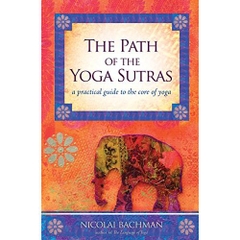-
-
-
Tổng tiền thanh toán:
-
-
Thông tin
-
Tìm sách theo yêu cầu
Book Description
Publication Date: August 16, 2011
Anatomy of Hatha Yoga - revised and updated with full color illustrations and photos--is the most comprehensive and authoritative work available correlating the study of hatha yoga with anatomy and physiology. It is a must-have for anyone who is serious about studying or teaching yoga, and an invaluable resource for anyone in a field relating to physical conditioning. The author holds a PhD in Anatomy and was a sought-after professor, teacher and yoga practitioner for over thirty years. He lived and taught at the Himalayan Institute for Yoga Science and Philosophy, and the University of Minnesota and Columbia University medical schools.
- Link: http://www.amazon.com/Anatomy-Hatha-Yoga-David-Coulter-ebook/dp/B005HJ5JYG
The book is unique in the literature, combining the breadth and depth of a textbook with the readability, humor and flow of the great science writers of our time, while bridging the gap between biomedicine and complementary medicine. In it, you will find a comprehensive overview of yoga anatomy and physiology, with special emphasis on the musculoskeletal, nervous, and cadiovascular systems.
The book presents the anatomy of yoga in scientific terms, while at the same time respecting its principles. The author discusses the basic premises of hatha yoga with foundational material accepted in biomedical sciences, expressly avoiding comment on non-physical concepts such as prana and the chakras. Postures are discussed in detail and depicted in excellent quality color photographs, accompanied by anatomical diagrams to illustrate critical processes and muscle groups.
Editorial Reviews
About the Author
H. David Coulter, Ph. D. From 1968 to 1986 taught various anatomy courses in the Department of Anatomy of the University of Minnesota (Medical School). During that period he also served as a principal investigator for neuroscience research funded by the National Institutes of Health and the National Science Foundation. He next taught in the Department of Anatomy and Cell Biology at Columbia University College of Physicians & Surgeons (1986 to 1988). Dr. Coulter was initiated by Swami Veda (formerly Dr. Usharbudh Arya), trained under Swami Rama from 1975 to 1996, and studied under Pandit Rajmani Tigunait at the Himalayan Institute since 1988 forward.
Product Details
File Size: 11123 KB
- Print Length: 622 pages
- Publisher: Body and Breath; 1st edition (August 16, 2011)
- Sold by: Amazon Digital Services, Inc.
- Language: English
- ISBN-10: 097070061X
- ISBN-13: 978-0970700612
- ASIN: B005HJ5JYG
- Text-to-Speech: Enabled

- X-Ray:Not Enabled

- Lending: Not Enabled
- Amazon Best Sellers Rank: #164,815 Paid in Kindle Store (See Top 100 Paid in Kindle Store)
Most Helpful Customer Reviews
291 of 294 people found the following review helpful
5.0 out of 5 stars Thorough and meticulous November 2, 2002
Format:Hardcover
This book is required for the yoga teacher training I am enrolled in. I've read it from cover to cover and I was blown away by the amount of information Coulter presents. He doesn't make references to specific schools but presents things very generally. He also doesn't use too much Sanskrit, so most yoga students shouldn't be too intimidated by the material.
The information he presents on Breathing, the importance of the Abdominopelvic muscles (or the "core muscles", as they're popularly known today) and his chapter on Forward Bends where he discusses nutation were my favorite portions. Coulter isn't doctrinaire in most cases, as is appropriate for someone discussing the anatomical aspect of yoga. He presents variations for the popular poses (forward bends, cobra, triangle, etc.) and discusses what the ramifications of the modifications are. While some are called "advanced" and some are called "beginner", it doesn't come off as a value judgment.
Because Coulter was so thorough throughout the entire book and backed up almost every statement with a logical explanation, it was noticeable when he did not. For instance, he, like almost every other author of a yoga text, recommends that women not practice inversions if they are menstruating. Why? I really hoped that someone with his background would be able to supply an explanation other than because that's the way it's been done. Also, while he spends quite a bit of time talking about the importance of the right tetrahedron for meditation postures and the various postures that can be used, I felt he glossed over the reasons why meditation has to be done sitting versus lying down. Minor quibbles, but only more obvious because the rest of the book is so meticulous.
If you are planning on teaching yoga, if you already have a yoga practice or if you're not quite convinced that yoga can do anything for your body, pick up this book.
The information he presents on Breathing, the importance of the Abdominopelvic muscles (or the "core muscles", as they're popularly known today) and his chapter on Forward Bends where he discusses nutation were my favorite portions. Coulter isn't doctrinaire in most cases, as is appropriate for someone discussing the anatomical aspect of yoga. He presents variations for the popular poses (forward bends, cobra, triangle, etc.) and discusses what the ramifications of the modifications are. While some are called "advanced" and some are called "beginner", it doesn't come off as a value judgment.
Because Coulter was so thorough throughout the entire book and backed up almost every statement with a logical explanation, it was noticeable when he did not. For instance, he, like almost every other author of a yoga text, recommends that women not practice inversions if they are menstruating. Why? I really hoped that someone with his background would be able to supply an explanation other than because that's the way it's been done. Also, while he spends quite a bit of time talking about the importance of the right tetrahedron for meditation postures and the various postures that can be used, I felt he glossed over the reasons why meditation has to be done sitting versus lying down. Minor quibbles, but only more obvious because the rest of the book is so meticulous.
If you are planning on teaching yoga, if you already have a yoga practice or if you're not quite convinced that yoga can do anything for your body, pick up this book.
4 Comments | Was this review helpful to you?
165 of 169 people found the following review helpful
5.0 out of 5 stars enrich your understanding and practice of yoga January 23, 2002
By escaravelha
Format:Hardcover|Verified Purchase
Coulter's comprehensive book provides a new bridge between the empirical traditions of yoga science, and Western physiology and anatomy. He uses his deep knowledge of both sides of the divide to provide detailed accounts of what is happening during yoga asanas and pranayama breathing. While I had expected this to be useful in providing answers for questions that I, my colleagues and students have had, trying to fit yoga into a Western scientific context, I have been delighted to find that there is a feedback loop, with the Western analysis making it easier to maintain the detailed instructions I had previously learned from teachers and other books.
This is an impressively detailed and exhaustive book, including coverage of movement and posture, breathing, many categories of asana, and relaxation and meditation. In each case, the physiological information is linked to practice, and often different levels of the posture are discussed. The writing style is clear and informal. There are anatomical diagrams, charts of breathing patterns, and photographs of the poses, but this is a long way from the current trend towards thumbnail pictures of every stage of a pose.
In such a thorough and dense volume (over 600 pages in all) the major challenge is easy access to specific information when you need it. There are two indexes, by anatomical term and by specific practices, but I would have welcomed more context within the indexes (for example, to direct me to the most appropriate of 12 mentions of the synovial joint). I think my carping on this topic will diminish my familiarity with the content grows, as I use the book more over the months and years -- which I certainly intend to do. Highly recommended.
This is an impressively detailed and exhaustive book, including coverage of movement and posture, breathing, many categories of asana, and relaxation and meditation. In each case, the physiological information is linked to practice, and often different levels of the posture are discussed. The writing style is clear and informal. There are anatomical diagrams, charts of breathing patterns, and photographs of the poses, but this is a long way from the current trend towards thumbnail pictures of every stage of a pose.
In such a thorough and dense volume (over 600 pages in all) the major challenge is easy access to specific information when you need it. There are two indexes, by anatomical term and by specific practices, but I would have welcomed more context within the indexes (for example, to direct me to the most appropriate of 12 mentions of the synovial joint). I think my carping on this topic will diminish my familiarity with the content grows, as I use the book more over the months and years -- which I certainly intend to do. Highly recommended.
93 of 96 people found the following review helpful
5.0 out of 5 stars Indispensable for yoga teachers and serious students April 10, 2002
Format:Hardcover
As hatha yoga approaches the "Granola Standard" of public acceptance -- it's not just for aging hippies and health nuts anymore --there's a growing need for foundational work in the anatomic and physiological effects of the discipline. It may still be a while before our leading medical schools issue texts examining yoga in detail, so former anatomy professor and dedicated yogi H. David Coulter, Ph.D. has done them a favor (and they, along with every HMO, hospital, and preventive-care clinic in the country should order copies now). In this exhaustive guide to the ups, downs, twists and turns of most fundamental asanas (and a few advanced ones), Coulter tells you a lot more than your recently certified yoga teacher may know about exactly what's going on with your body during the yogic experience. (Yoga teachers, you should order now too!) And the author has the seasoning to issue knowledgeable warnings about the fact that, poorly practiced, yoga can certainly be bad for you: "Cultivate a frolicsome enthusiasm in the morning to counter stiffness, and cautiousness in the evening to avoid hurting yourself. And at any time, if you start feeling uncommonly strong, flexible, and frisky, be careful. That's when it?s easy to go too far."
In these days when most books are more cheaply made than ever, it's nice to see a volume like this that's built to last; the glossy text paper gives the book the physical heft and authority to match the value of the content. The pricetag is what you're used to seeing on the latest computer books, but when you consider that this tome will be timely for years instead of months, it's a real bargain. -- P.MILLER for the FEARLESS REVIEWS
In these days when most books are more cheaply made than ever, it's nice to see a volume like this that's built to last; the glossy text paper gives the book the physical heft and authority to match the value of the content. The pricetag is what you're used to seeing on the latest computer books, but when you consider that this tome will be timely for years instead of months, it's a real bargain. -- P.MILLER for the FEARLESS REVIEWS
XEM CHI TIẾT TẠI AMAZON.COM
- Thông tin chi tiết
- Mục lục
- Đánh giá & bình luận của người mua
- Những cuốn sách cùng chủ đề hoặc có liên quan
Tại web chỉ có một phần nhỏ các đầu sách đang có nên nếu cần tìm sách gì các bạn có thể liên hệ trực tiếp với Thư viện qua Mail, Zalo, Fanpage nhé
Đăng ký nhận tin qua email
Hãy đăng ký ngay hôm nay để nhận được những tin tức cập nhật mới nhất về sản phẩm và các chương trình giảm giá, khuyến mại của chúng tôi.












